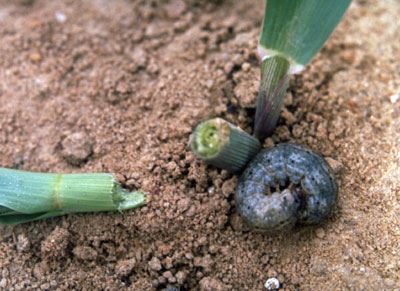Black Cutworm Appears In Northeastern Missouri
SHELBYVILLE, MO.
University of Missouri Extension specialists are seeing early indications of black cutworm in northeastern Missouri.
Agronomy specialist Max Glover reports catching high numbers of black cutworm moths. These moths will lay eggs that might result in high numbers of black cutworm larvae that can cut stems of corn, soybean, wheat, turfgrasses and other plants.
First-generation larvae cause the most crop damage in Missouri, said Wayne Bailey, entomology specialist for MU Extension. Second-generation larvae target later-planted crops.
As larvae increase in size, they may destroy several plants in a single night, Bailey said. Plants may be cut above or below the soil’s surface. When soil conditions are dry, cutworm larvae drag cut plants into their burrows.
The black cutworm larvae curl into a characteristic “C” shape when disturbed and play dead until danger passes. Their skin is rough and grainy and ranges in color from light gray to black. A black daggerlike marking on its forewings identifies the cutworm in the moth stage. The black cutworm lays eggs in low, wet areas of a field.

Black cutworm larvae curl into a characteristic "C" shape when disturbed and play dead until the danger passes.
Credit: W.M. Hantsbarger, Bugwood.org
Black cutworm is difficult to detect because they are active mainly at night. They hide in cracks or in their burrows during the day. Begin scouting when plants emerge, Bailey said, because damage occurs quickly. Examine 25 consecutive plants in 10 different areas of a field to determine damage, larval size and feeding locations. Bailey suggests digging around plants and underneath dirt clods to locate larvae.
Scout for cutworms until cornstalks have four to five leaves, and scout for two weeks after emergence on other crops.
Bailey said black cutworms and other cutworm species are a challenge to manage, especially when fields are dry. Avoid planting crops, especially corn, following long-standing pasture, alfalfa or red clover. Shallow tillage in the fall or spring reduces late fall and early spring weed growth. He also suggests destroying vegetation at least 14 days before planting crops. This makes the fields less attractive to migrating moths.
Timed insecticide treatments help to control cutworms, but are less effective when fields are dry.
MU Extension offers a free guide, “Black Cutworm in Missouri,” available for download at extension.missouri.edu/p/G7112. ∆